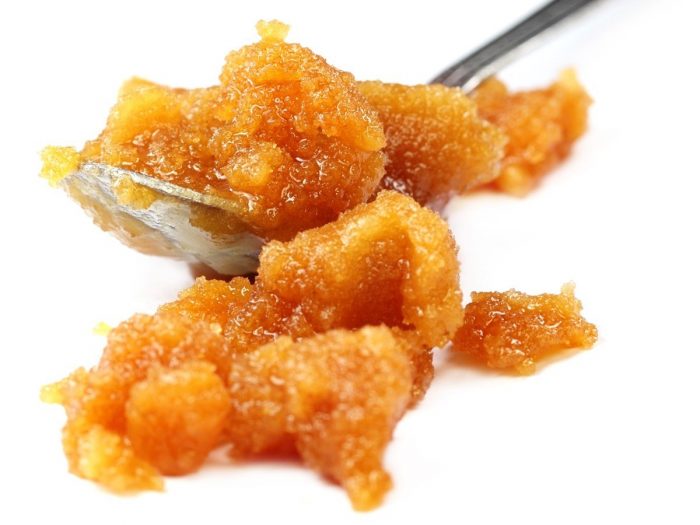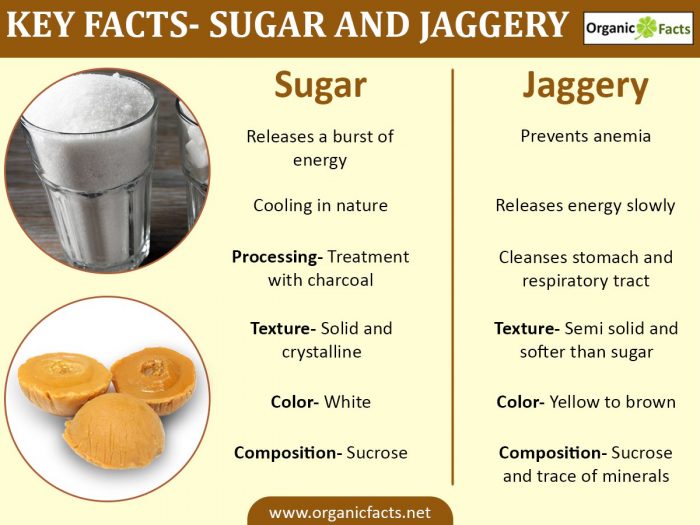Sugar and jaggery are two common sweeteners used throughout the world. Although both jaggery and sugar are obtained from the same sources, they are much different in their properties and benefits.
Just as two identical twins born of the same parents are different in many respects; jaggery and sugar, born of the same sugar cane juice, are different from one another. These differences must be kept in mind for their proper use. Let us have a look at these differences.

Difference in Color
Sugar and jaggery are completely different in color.
Sugar: Sugar typically has a bright white color.
Jaggery: Jaggery shows some true Eastman colours, ranging from golden yellow to golden brown, brown, dark brown and like the color of dark chocolate, depending upon the extent to which it was cooked.
Difference in Texture
Sugar and jaggery vary greatly in texture as well.
Sugar: Sugar is solid, hard and crystalline.
Jaggery: Jaggery is semi-solid, softer than sugar, and amorphous.
Difference in Processing
The first stage of the manufacturing of jaggery and sugar is the same. This first step is the boiling of sugar cane juice. It changes from that point however, as explained below.
Sugar: After the initial boiling, in the case of sugar, this syrup is treated with charcoal (preferably bone charcoal) to absorb unwanted particles and to give a clear, transparent solution. This solution, once it condenses and crystallizes, results in the commonly known form of sugar.
Jaggery: In the case of jaggery, there is no treatment with any kind of charcoal, nor there is any kind of crystallization. That is why, in India, particularly among Hindus, jaggery is considered sacred, while white sugar is not. For jaggery, the mother syrup is boiled and boiled continuously until it is formed into a thick paste, which is then poured into molds to make blocks of jaggery of the desired quantity.
Difference in Composition
Both Jaggery and Sugar are predominantly made up of sucrose, but there are some differences.
Sugar: Only sucrose (C12H22O12).
Jaggery: Predominantly sucrose (C12H22O12), with traces of mineral salts, iron and some fiber.
Difference in Health Benefits
Although both jaggery and sugar are meant for providing energy for the body, their mode of energy release is somewhat different.
Sugar: Being one of the simplest available forms of sucrose, sugar is instantly absorbed in the blood and releases a burst of energy. This may prove harmful for some internal organs such as the kidneys, eyes, and brain, particularly for patients with diabetes. Again, for some unknown reason, sugar solution in water is considered cooling in nature. So, in some places, it is not recommended to consume sugar when someone has a cold.
Jaggery: Jaggery is far more complex than sugar, as it is made up of longer chains of sucrose. Hence, it is digested slower than sugar and releases energy slowly and not instantaneously. This provides energy for a longer time and is not harmful for the body. However, this does not certify it as fit for consumption by diabetics, because ultimately, it is still sugar. Jaggery also gathers a considerable amount of ferrous salts (iron) during its preparation, as it is prepared in iron vessels. This iron is also good for health, particularly for those who are anemic or lack iron. Again, jaggery also contains of traces of mineral salts which are very beneficial for the body. You might have experienced this when consuming jaggery, it leaves a hint of salt on the tongue. These salts come from the sugar cane juice where it is absorbed from the soil. Furthermore, jaggery is very good as a cleansing agent. It cleanses the lungs, stomach, intestines, esophagus and respiratory tracts. Those who face dust in their day to day life are highly recommended to take a daily dose of jaggery. This can keep them safe from asthma, cough, cold, and congestion in chest.Read more about the benefits of jaggery
Difference in Cultural Aspects
Sugar and jaggery turn out to be just the opposite when it comes to the cultural aspects.
Sugar: It has almost no place in Indian culture or religious activities, perhaps because it is considered of foreign origin and made with the help of bone charcoal.
Jaggery: Jaggery has an important place in Indian culture, and perhaps also in the culture of any country where it is made, probably because it is indigenous. In India, it is offered to gods and goddesses and is used in many religious ceremonies because it is considered holy, as it does not involve any use of bone charcoal.
 Difference in Industrial Aspects and Marketing
Difference in Industrial Aspects and Marketing
Again, there are some big differences.
Sugar: The sugar industry is very organized and highly mechanized, as almost all the sugar coming to the market is manufactured in sugar mills run by big companies. Hence, sugar is branded and it has a big influence on the CPI and thus on the economy.
Jaggery: Despite the fact that jaggery manufacturing has been practiced for centuries, much before sugar came into being and that there is a big market for it, this industry is still not organized and could not come out of the realms of the rural areas. Most of the jaggery comes from remote rural places and reach the market through agents. Unlike sugar, jaggery is known by the place of its manufacture and not by brands.
Difference in Culinary & Industrial Uses
Naturally, these differences are very interesting to discuss.
Sugar: You name it, and you have it! Sugar is found in almost every sweet thing. The whole of the sugar-boiled confectionery industry is dependent on sugar. It is used in bakery items like breads, cakes, biscuits, cookies and other bakery products. It is found in almost every sweet dish cooked in households and also in other dishes to boost the taste, including sorbets, syrups, jams, jellies, sauces, marmalade, squashes, soft drinks, packed fruit juices and sweetened milks, milk chocolates, ice creams, ice candies, condensed milks and….., this list can go on infinitely. It is also used in some medicines. Sugar is caramelized and mixed with a number of food items and beverages, including alcoholic beverages, to add taste, color and aroma.
 Jaggery: Although jaggery is not as widely used as sugar, it is still very popular in Indian culinary practices. It is used in curries, lentil soups and other preparations. It is an integral part of country sweets made by combining ground nuts, grams, sesame seeds, rice flakes, puffed rice, popped rice, cashew nuts, almonds, wheat, and gram flour snacks with jaggery. These sweets are extensively consumed during the winter all over India and they provide nutrition and warmth to combat the cold. There is one big industrial use of jaggery, and that is in the manufacturing of alcoholic beverages, particularly rum. Rum, in many cases, is made by fermenting jaggery.
Jaggery: Although jaggery is not as widely used as sugar, it is still very popular in Indian culinary practices. It is used in curries, lentil soups and other preparations. It is an integral part of country sweets made by combining ground nuts, grams, sesame seeds, rice flakes, puffed rice, popped rice, cashew nuts, almonds, wheat, and gram flour snacks with jaggery. These sweets are extensively consumed during the winter all over India and they provide nutrition and warmth to combat the cold. There is one big industrial use of jaggery, and that is in the manufacturing of alcoholic beverages, particularly rum. Rum, in many cases, is made by fermenting jaggery.
Difference in Availability
This difference is huge!
Sugar: It is available almost anywhere in the world now, if you leave out the dense forests of the Amazon, parts of Africa, and Mt. Everest. Availability is never a problem with sugar. Just reach out your hand and you can probably find it.
Jaggery: If you are not living in a country where jaggery is manufactured, it might be very difficult to find. It is exported to very few countries from the countries where it is produced, due to the fact that since it contains a lot of moisture, often melts on heating, and contracts fungal infections quite easily. Hence, its transport and storage is a problem. Still, you may be able to get your hands on some if you search shops that keep Indian or Asian food articles. Date palm jaggery and Palmyra jaggery are even more rarely available than Sugar cane jaggery; the reason being its very limited production.
That was a comparative analysis of sugar and jaggery. Those who have not tasted jaggery yet, it won’t hurt to try. You will love its great taste and impressive health benefits.
No comments:
Post a Comment